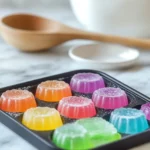Cranberry Orange Bread is a delightful combination of sweet and tangy flavors, making it a perfect treat for various occasions. The tartness of cranberries blends seamlessly with the refreshing citrus notes of orange, creating a balanced flavor profile that’s both vibrant and comforting. This bread is not just a holiday favorite but also a wonderful addition to any brunch, breakfast, or afternoon snack. Whether you’re enjoying a slice on a chilly winter morning or serving it to guests during festive gatherings, its unique mix of flavors is sure to please any crowd.
Why This Recipe Stands Out
This Cranberry Orange Bread recipe stands out due to its moist, tender texture and its unique combination of flavors. The fresh or frozen cranberries provide a sharp tang, while the orange zest and glaze offer a refreshing citrus punch. The homemade aspect of this bread guarantees a superior texture and flavor compared to store-bought versions, which often lack freshness.
One of the key highlights is the added orange syrup, which soaks into the bread, ensuring every bite bursts with flavor. The simple glaze, made with orange juice and confectioner’s sugar, adds a sweet and tangy finish that enhances the overall taste. These small steps elevate this bread from ordinary to exceptional, making it a standout recipe for any occasion.
Ingredients Breakdown: What You Need
For the Bread:
- All-purpose flour: The foundation of the bread, providing structure and stability.
- Baking powder: Acts as the leavening agent, helping the bread rise and become fluffy.
- Kosher salt: Enhances the flavors by balancing sweetness and adding depth.
- Whole milk yogurt: A key ingredient for moisture, it adds a slight tang and richness that keeps the bread soft.
- Sugar: Provides sweetness and structure, caramelizing during baking to give the bread a light crust.
- Eggs: Bind the ingredients together, contributing to the bread’s structure and moisture.
- Orange zest: The zest from the orange adds a vibrant, concentrated citrus flavor that permeates the bread.
- Pure vanilla extract: Adds warmth and enhances the flavors of the other ingredients.
- Vegetable oil: Keeps the bread moist and tender, offering a light texture.
- Cranberries (fresh or frozen): The star ingredient, providing a tart contrast to the sweet and citrusy elements.
For the Orange Syrup:
- Orange juice: Freshly squeezed orange juice adds a bright citrus flavor and moisture to the bread.
- Sugar: Sweetens the syrup and helps it soak into the bread, making it more flavorful and moist.
For the Orange Glaze:
- Confectioner’s sugar: Provides a smooth, sweet base for the glaze.
- Fresh orange juice: Adds a fresh citrus punch, balancing the sweetness of the glaze for the perfect finishing touch.
Step-by-Step Recipe Process and Expert Tips
1. Preheat the Oven and Prepare the Loaf Pan
Preheating the oven is an essential first step for ensuring even baking. Set your oven to 350°F (175°C) and allow it to heat thoroughly while you prepare the batter. Proper preheating ensures that the bread begins to rise immediately upon entering the oven, resulting in a soft, fluffy texture. Meanwhile, greasing and flouring your loaf pan is crucial to prevent the bread from sticking. Use butter or non-stick spray to coat the pan, then dust it lightly with flour, tapping out the excess. This preparation helps the bread release smoothly, preserving its shape and texture.
2. Mixing the Dry Ingredients
In a medium bowl, sift together 1 1/2 cups of all-purpose flour, 2 teaspoons of baking powder, and 1/2 teaspoon of kosher salt. Sifting is important because it breaks up any lumps in the flour and aerates it, ensuring a light and even texture in the bread. Properly combining the dry ingredients also helps distribute the baking powder and salt, so the bread rises uniformly. If the dry ingredients are not mixed thoroughly, you risk having uneven pockets of flour or baking powder, which can affect the texture and taste of the finished product.

3. Whisking Wet Ingredients Together
In a separate, larger bowl, combine 1 cup of whole milk yogurt, 1 cup of sugar, 3 large eggs, 2 teaspoons of grated orange zest, 1/2 teaspoon of pure vanilla extract, and 1/2 cup of vegetable oil. The yogurt is a game-changer in this recipe, as its natural acidity reacts with the baking powder, helping the bread rise while keeping it moist and tender.
Whisking the eggs well is crucial for incorporating air into the batter, which contributes to the bread’s light, fluffy texture. Ensure that the sugar dissolves into the wet ingredients for a smooth batter, while the orange zest adds a refreshing citrus aroma and flavor that complements the tart cranberries. The vanilla extract brings warmth, and the vegetable oil provides moisture, ensuring that the bread stays soft even after baking.
4. Combining the Wet and Dry Ingredients
Gradually add the dry ingredients to the wet mixture, stirring gently with a spatula or wooden spoon. It’s important to mix just until the flour disappears into the batter to avoid overmixing, which can lead to a dense or tough texture. Overworking the batter activates the gluten in the flour, making the bread chewy rather than soft. To ensure a smooth, lump-free batter, fold the ingredients together rather than stirring vigorously. This gentle method preserves the bread’s tender crumb and allows for even distribution of ingredients without compromising texture.
5. Coating Cranberries with Flour (100 words)
Before folding the cranberries into the batter, toss them in 1 tablespoon of all-purpose flour. This simple step prevents the cranberries from sinking to the bottom of the loaf during baking, ensuring even distribution throughout the bread. The flour coats the cranberries, giving them a bit of structure within the batter. Whether you are using fresh or frozen cranberries, the process remains the same. If using frozen cranberries, make sure they are fully thawed and patted dry to avoid excess moisture, which could affect the consistency of the batter.
6. Baking the Bread: Time and Temperature
Once the batter is ready, pour it into the greased and floured loaf pan, spreading it evenly. Bake the bread in a preheated 350°F (175°C) oven for 50-55 minutes. Baking at this temperature ensures that the bread cooks evenly without burning the outside before the center is fully baked.
To check if the bread is done, insert a toothpick into the center of the loaf. If it comes out clean or with a few moist crumbs attached, the bread is ready. Avoid overbaking, as it can dry out the bread. If the top of the loaf browns too quickly while baking, loosely cover it with foil to prevent over-browning while allowing the interior to finish baking.
7. Cooling the Bread: Why It Matters
Once the bread is done baking, allow it to cool in the pan for about 10 minutes. Cooling the bread in the pan helps it to set and makes it easier to remove from the loaf pan without breaking. After 10 minutes, carefully transfer the bread to a wire rack to cool completely. This step is crucial because cooling the bread on a rack allows air to circulate, preventing the bottom of the loaf from becoming soggy. Rushing the cooling process or skipping this step can lead to a dense or uneven texture, affecting the final result.
The Finishing Touches—Orange Syrup and Glaze
1. Making the Orange Syrup
To make the orange syrup, combine 1/3 cup of fresh orange juice and 1/3 cup of sugar in a small saucepan. Heat the mixture over medium heat, stirring occasionally until the sugar is fully dissolved. Once the sugar has melted, allow the mixture to simmer for 2-3 minutes, which helps to thicken the syrup slightly. The syrup should be thin enough to soak into the bread but thick enough to add flavor.
The orange syrup serves two important purposes: it infuses the bread with a concentrated orange flavor and keeps it moist. By soaking into the bread, the syrup enhances the citrus profile, ensuring that each bite bursts with tangy sweetness. Additionally, it adds moisture, making the bread even softer and prolonging its freshness. The syrup works in harmony with the cranberries and orange zest, tying all the flavors together beautifully.
2. Soaking the Bread with Orange Syrup
Once the bread has cooled for about 10 minutes and is still slightly warm, it’s time to apply the orange syrup. Use a toothpick or a thin skewer to poke small holes throughout the top and sides of the bread. These holes allow the syrup to penetrate the bread evenly, ensuring that the orange flavor is well distributed.
Brush the syrup generously over the top and sides of the bread, allowing it to soak into the holes. It’s important to apply the syrup while the bread is still warm, as the heat helps the syrup absorb more effectively and enhances the overall flavor.
3. Making the Orange Glaze
To prepare the glaze, whisk together 1 cup of sifted confectioner’s sugar and 2-3 tablespoons of fresh orange juice in a small bowl. Start with 2 tablespoons of juice, and if the glaze is too thick, add more orange juice a teaspoon at a time until you reach the desired consistency. The glaze should be smooth, pourable, and thick enough to coat the bread without running off completely.
The glaze adds a final burst of citrus sweetness, balancing the tanginess of the cranberries and the richness of the bread. It also provides a beautiful, glossy finish, making the loaf visually appealing. The orange glaze perfectly complements the orange syrup, creating layers of flavor and texture that elevate the bread. The fresh orange juice in the glaze ensures that the citrus notes remain bright and refreshing.
4. Drizzling the Glaze Over the Bread
When the bread has cooled completely, it’s time to drizzle the orange glaze over the top. Use a spoon or a small pitcher to drizzle the glaze in a zigzag pattern, allowing it to cascade down the sides of the loaf. For an even coating, make sure to distribute the glaze across the entire surface.
Let the glaze harden for about 10-15 minutes before slicing. This step is crucial, as a hardened glaze ensures that the presentation remains clean and professional. The set glaze not only looks elegant but also adds a delightful sweetness and texture to each bite.
Serving Suggestions and Storage
Serving Tips
For the best presentation, slice the Cranberry Orange Bread with a serrated knife to avoid squishing the soft interior. Cut the loaf into thick slices, about ¾ to 1 inch, to fully enjoy the moist texture and flavor in each bite. This bread is perfect served slightly warm or at room temperature.
Ideal pairings include a hot cup of coffee or tea, as the sweetness of the bread balances the bitterness of these beverages. You can also serve it as part of a brunch spread, alongside scrambled eggs, fresh fruit, or yogurt for a delightful, balanced meal.
Storage and Freezing
To keep the bread fresh, store it in an airtight container at room temperature for up to 3 days. If you want to extend its freshness, wrap it tightly in plastic wrap or aluminum foil and refrigerate for up to 1 week.
Yes, you can freeze this bread! Wrap individual slices or the whole loaf in plastic wrap, then place it in a freezer-safe bag. The bread will last in the freezer for up to 3 months. To reheat, thaw at room temperature and warm slices in a toaster or microwave for a freshly baked experience.
FAQ Section
Can I use dried cranberries instead of fresh or frozen?
Yes, but soak them in hot water for 10-15 minutes to plump them up before using to avoid dryness.
What can I substitute for yogurt?
You can use sour cream or buttermilk as a substitute for yogurt; both will maintain the moisture and tangy flavor.
How can I make the bread gluten-free?
Use a gluten-free all-purpose flour blend with xanthan gum to replace regular flour.
Can I omit the orange glaze?
Yes, the bread will still be delicious without the glaze, though the glaze adds a sweeter, more polished finish.
How do I prevent the cranberries from sinking to the bottom?
Toss the cranberries in a tablespoon of flour before folding them into the batter to keep them evenly distributed.
Conclusion
Cranberry Orange Bread is a must-try recipe due to its perfect balance of tart cranberries, refreshing citrus, and sweet glaze. Its moist texture and vibrant flavors make it suitable for any occasion, from casual breakfasts to festive gatherings. For variations, consider adding chopped nuts for crunch or substituting lemon zest and juice for a different citrus twist. Feel free to experiment with ingredients to make the recipe your own, whether adjusting the sweetness or incorporating your favorite flavors. This versatile bread invites creativity, ensuring it’s a beloved addition to your recipe collection.
Print
Cranberry Orange Bread with Simple Glaze
Description
This Cranberry Orange Bread is a delightful blend of tart cranberries and zesty orange, complemented by a moist texture and a sweet, citrusy glaze. The bread is perfect for breakfast, brunch, or as a festive holiday treat. The orange syrup infuses the bread with a bright citrus flavor, while the glaze adds a smooth and sweet finish. Easy to make, this bread is sure to impress your family and friends with its balanced flavors and tender crumb.
Ingredients
For the Bread:
- 1 ½ cups + 1 tablespoon all-purpose flour (divided)
- 2 teaspoons baking powder
- ½ teaspoon kosher salt
- 1 cup plain whole milk yogurt
- 1 cup sugar
- 3 large eggs
- 2 teaspoons grated orange zest
- ½ teaspoon pure vanilla extract
- ½ cup vegetable oil
- 1 ½ cups fresh or frozen cranberries (thawed if frozen)
For the Orange Syrup:
- ⅓ cup fresh orange juice
- ⅓ cup sugar
For the Orange Glaze:
- 1 cup sifted confectioner’s sugar
- 2–3 tablespoons fresh orange juice
Instructions
1. Preheat the Oven:
Preheat your oven to 350°F (175°C). Grease and flour a 9×5-inch loaf pan, tapping out any excess flour to ensure the bread doesn’t stick.
2. Mix the Dry Ingredients:
In a medium bowl, sift together 1 ½ cups of flour, baking powder, and kosher salt. Sifting helps ensure an even distribution of dry ingredients for a lighter, smoother texture.
3. Mix the Wet Ingredients:
In a large bowl, whisk together the yogurt, sugar, eggs, orange zest, vanilla extract, and vegetable oil until smooth. The yogurt helps keep the bread moist while providing a slight tang.
4. Combine the Wet and Dry Ingredients:
Gradually add the dry ingredients to the wet mixture, stirring just until combined to avoid overmixing, which can result in dense bread.
5. Coat the Cranberries:
Toss the cranberries with the remaining tablespoon of flour to prevent them from sinking to the bottom of the loaf.
6. Pour and Bake:
Fold the cranberries into the batter and pour it into the prepared loaf pan. Bake for 50-55 minutes, or until a toothpick inserted into the center comes out clean, with a few moist crumbs attached.
7. Prepare the Orange Syrup:
In a small saucepan, combine the orange juice and sugar. Heat over medium heat until the sugar dissolves. Let it simmer for an additional 2-3 minutes, then remove from heat.
8. Soak the Bread:
Once the bread has cooled slightly in the pan for 10 minutes, poke holes in the top and sides using a toothpick. Brush the orange syrup over the bread, allowing it to soak in for added moisture and flavor.
9. Make the Glaze:
Whisk together the confectioner’s sugar and fresh orange juice in a small bowl until smooth. Adjust the consistency with more orange juice if needed.
10. Glaze the Bread:
Drizzle the glaze over the cooled loaf, letting it run down the sides. Allow the glaze to harden before slicing and serving.
Notes
- Fresh vs. Frozen Cranberries: Both fresh and frozen cranberries work well in this recipe. If using frozen cranberries, ensure they are thawed and patted dry to avoid adding extra moisture to the batter.
- Yogurt Substitutes: If you don’t have whole milk yogurt on hand, you can substitute it with sour cream or buttermilk for a similar effect. These will help maintain the moisture and slight tang in the bread.
- Preventing Sinking Cranberries: Tossing the cranberries in flour helps to keep them evenly distributed throughout the loaf, so they don’t sink to the bottom during baking.
- Glaze Consistency: If the glaze is too thick, add more orange juice 1 teaspoon at a time until it reaches the right consistency. If it’s too thin, add a little more confectioner’s sugar.
- Storage: The bread can be stored in an airtight container at room temperature for 2-3 days, refrigerated for up to 1 week, or frozen for up to 3 months. If freezing, wrap the bread tightly in plastic wrap and aluminum foil to preserve freshness.









